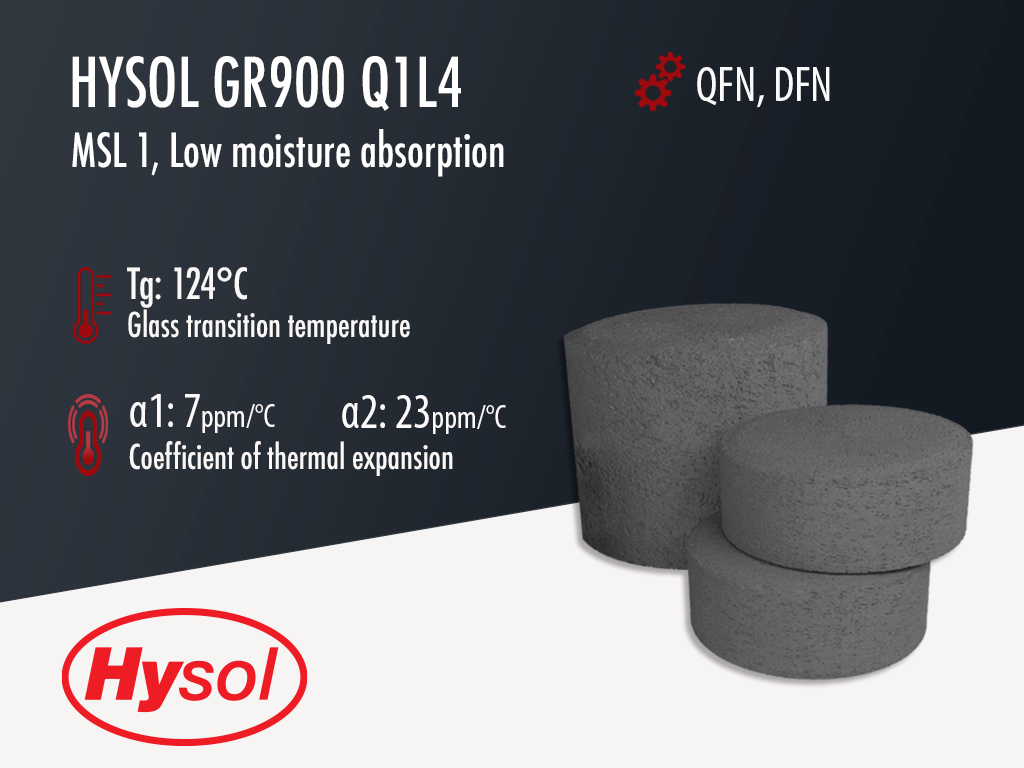Hysol GR900 Q1L4 | Black Epoxy Mold Compound
- MSL1 260°C
- Designed for QFN and DFn packages
- Compatible with Copper Wire
Product Description
Hysol GR900 Q1L4 is a black semiconductor-grade epoxy molding compounddesigned for the encapsulation and protection of quad-flat no-leads (QFN) and dual-flat no-leads (DFN). Once molded and post-mold cured, this product provides optimum protection and reliability for these semiconductor devices.
Hysol GR900 Q1L4 is a spherical silica filled (89%) EMC, typically used for QFN and DFN packages. QFN and DFN packages are low-profile packages that are MAP molded. This means that the packages are molded together in one large mold and then separated by cutting through the entire package. Epoxy molding compounds made for these type packages must have a low warpage, and GR900 Q1L4 is no exception. This product is formulated to have a very low internal stress to reduce warpage, as well as low moisture absorption to increase MSL performance.
Hysol GR900 Q1L4 is an environmentally "green" halogen free product, meaning that it doesn't contain any bromine, antimony or phosphorus flame retardants. Previous MG-series EMC dominated the space for power semiconductors but used halogen-containing flame retardants. This next generation epoxy mold compound replaces these older generation products. To add to that, this material is designed to achieve JEDEC Level 1 requirements at 260°C reflow temperature on preplated or NiPdAu leadframes. It meets UL 94 V-0 Flammability at 1/8 inch (3.18mm) thickness.
Technical Specifications
| General Properties | |||||||||
| Color Color The color | Black | ||||||||
| Filler Content | 89 % | ||||||||
| Specific Gravity Specific Gravity Specific gravity (SG) is the ratio of the density of a substance to the density of a reference substance; equivalently, it is the ratio of the mass of a substance to the mass of a reference substance for the same given volume. For liquids, the reference substance is almost always water (1), while for gases, it is air (1.18) at room temperature. Specific gravity is unitless. | 2.02 | ||||||||
| |||||||||
| Electrical Properties | |||||||||
| Volume Resistivity Volume Resistivity Volume resistivity, also called volume resistance, bulk resistance or bulk resistivity is a thickness dependent measurement of the resistivity of a material perpendicular to the plane of the surface. | 2.7x1016 Ohms⋅cm | ||||||||
| Chemical Properties | |||||||||
| |||||||||
| Physical Properties | |||||||||
| Spiral Flow @ 175°C | 124 cm | ||||||||
| Thermal Properties | |||||||||
| Glass Transition Temperature (Tg) Glass Transition Temperature (Tg) The glass transition temperature for organic adhesives is a temperature region where the polymers change from glassy and brittle to soft and rubbery. Increasing the temperature further continues the softening process as the viscosity drops too. Temperatures between the glass transition temperature and below the decomposition point of the adhesive are the best region for bonding. The glass-transition temperature Tg of a material characterizes the range of temperatures over which this glass transition occurs. | 124 °C | ||||||||
| Thermal Conductivity Thermal Conductivity Thermal conductivity describes the ability of a material to conduct heat. It is required by power packages in order to dissipate heat and maintain stable electrical performance. Thermal conductivity units are [W/(m K)] in the SI system and [Btu/(hr ft °F)] in the Imperial system. | 0.9 W/m.K | ||||||||
| UL 94 Rating UL 94 Rating Flammability rating classification. It determines how fast a material burns or extinguishes once it is ignited. HB: slow burning on a horizontal specimen; burning rate less than 76 mm/min for thickness less than 3 mm or burning stops before 100 mm V-2: burning stops within 30 seconds on a vertical specimen; drips of flaming particles are allowed. V-1: burning stops within 30 seconds on a vertical specimen; drips of particles allowed as long as they are not inflamed. V-0: burning stops within 10 seconds on a vertical specimen; drips of particles allowed as long as they are not inflamed. 5VB: burning stops within 60 seconds on a vertical specimen; no drips allowed; plaque specimens may develop a hole. 5VA: burning stops within 60 seconds on a vertical specimen; no drips allowed; plaque specimens may not develop a hole | V0 | ||||||||
| |||||||||
| |||||||||
| Mechanical Properties | |||||||||
| Molded Shrinkage | 0.19 % | ||||||||
| |||||||||
| |||||||||
| |||||||||
| |||||||||
| Curing Conditions | |||||||||
| Transfer Pressure | 40 - 100 kg/cm2 | ||||||||
| Transfer Time | 5 - 30 s | ||||||||
| |||||||||
| |||||||||



